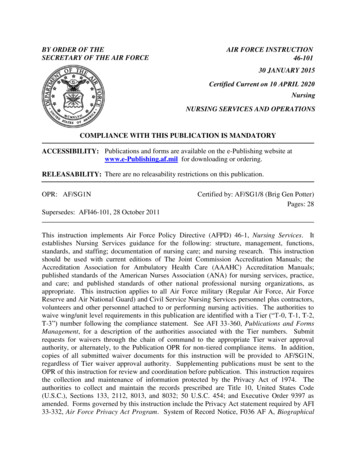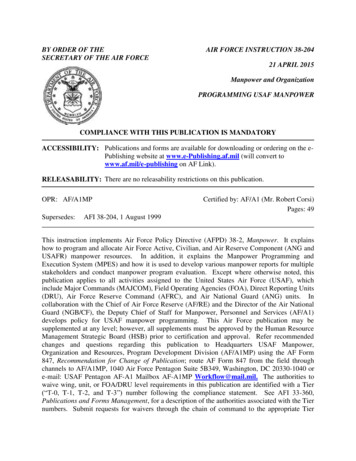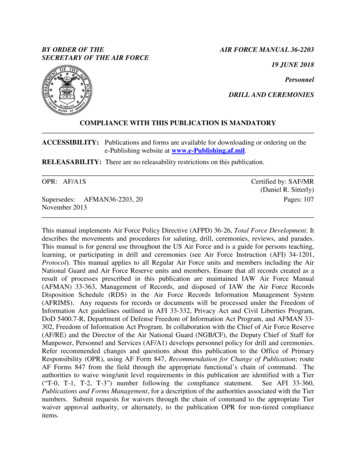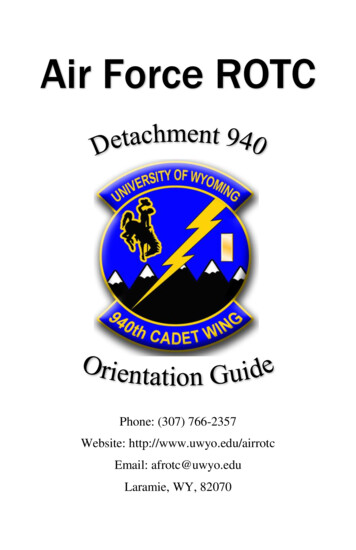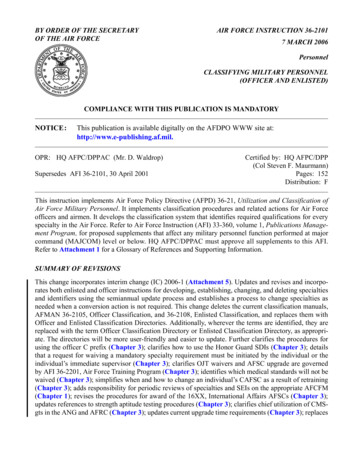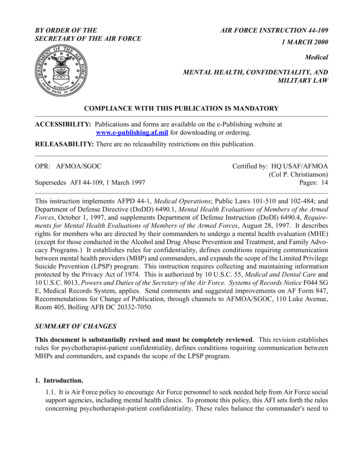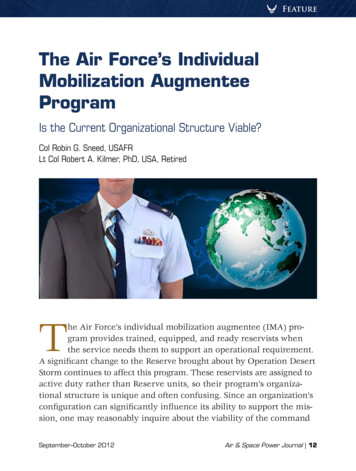
Transcription
FeatureThe Air Force’s IndividualMobilization AugmenteeProgramIs the Current Organizational Structure Viable?Col Robin G. Sneed, USAFRLt Col Robert A. Kilmer, PhD, USA, RetiredThe Air Force’s individual mobilization augmentee (IMA) pro gram provides trained, equipped, and ready reservists whenthe service needs them to support an operational requirement.A significant change to the Reserve brought about by Operation DesertStorm continues to affect this program. These reservists are assigned toactive duty rather than Reserve units, so their program’s organiza tional structure is unique and often confusing. Since an organization’sconfiguration can significantly influence its ability to support the mis sion, one may reasonably inquire about the viability of the commandSeptember–October 2012Air & Space Power Journal 12
FeatureThe Air Force’s Individual Mobilization Augmentee ProgramSneed & Kilmerstructure of the Air Force’s current IMA program. This article usesStafford Beer’s viable system model as an analytical tool to examinethat structure.1 The evaluation presented here focuses on optimizingthe management of IMA forces to ensure increased operational readi ness in times of crisis; it also addresses the need to meet reservists’reasonable expectations that the Air Force use them in roles for whichthey are well suited and well trained, as well as roles consistent withan integrated All-Volunteer Force.The Individual Mobilization AugmenteeThe IMA program immediately augments active duty units in timeof war or national crisis by assigning reservists to them for trainingprior to such events. Instead of spending weeks or months trying tounderstand a unit’s unique personalities and relationships, the IMAwho has experience with the unit can step in and provide seamlesssupport. This concept of Reserve support has been part of the AirForce since activation of the Reserve in 1948 when Lt Gen George E.Stratemeyer, commander of Air Defense Command, assigned reserviststo key command positions for training as understudies and availabilityin case of general mobilization.2 Although often questioned in peace time, the concept effectively supported the active duty service duringOperation Desert Shield / Desert Storm, the last time the president ac tivated IMAs under title 10. Currently, by volunteering for activation,IMAs offer critical active duty support to deployments of air and spaceexpeditionary forces and other missions through man-day tours.3The Air Force defines an IMA as “an individual filling a military billetidentified as augmenting the active component structure of the De partment of Defense [DOD] or other departments or agencies of theU.S. Government.”4 The perception of the IMA role remains one ofbackfill capacity, but the validation process has expanded to includemobilization, contingency operations, specialized or technical require ments, and even economic considerations.5 Like most other reservists,IMAs serve part-time, typically 30 days annually, having the primarySeptember–October 2012Air & Space Power Journal 13
FeatureSneed & KilmerThe Air Force’s Individual Mobilization Augmentee Programmilitary responsibility of meeting the Air Force’s mobilization needs.For reservists and their supervisors, this translates into meeting anddocumenting compliance with the service’s fitness, medical, dental,security clearance, and specialty code training demands. Commandand unit training requirements may also come into play.For active duty supervisors and commanders, the integration of parttime reservists presents unique challenges. Some aspects of these re servists, such as their flexible participation dates and unique civilianskills, prove beneficial, yet mastering different paperwork and writingperformance reviews of part-time Airmen create issues even for themost conscientious supervisors. Given the primary emphasis, appro priately, on the unit mission, the prioritization of tasks can often lessenthe importance of training and supporting IMAs. Therefore, they mustfrequently take the initiative—schedule their own training, identifytheir duty activities, and manage their own careers. The understand ing that IMA is an abbreviation for “I’m alone” does not seem amusingto the reservist.Despite such difficulties, the IMA program continues to exist becausecommanders find ways to integrate these reservists into the unit in amanner that ensures appropriate training and supports unit goals.When used effectively, senior personnel with the appropriate trainingcan offset deficiencies in the active duty realm. The Air Force can ex ploit particular civilian skills and experiences to address unit issues.Moreover, fresh perspectives and unconventional viewpoints—the re sult of periodic unit participation—can combat groupthink and identifynew solutions. Oftentimes, successful IMAs are also exceptional per formers and people since they continue to support national defense ascitizen-Airmen and have learned to balance their military duties, civil ian careers, and family commitments. As the number of active dutymembers continues to decline, IMAs also become the face of the AirForce to their communities and businesses.September–October 2012Air & Space Power Journal 14
FeatureSneed & KilmerThe Air Force’s Individual Mobilization Augmentee ProgramOrganizational Structure of the IMA ProgramBecause IMAs are reservists assigned to active duty units, neitherthe Reserve’s nor the major commands’ (MAJCOM) hierarchical orga nization can effectively manage the program. Therefore program re sponsibilities have been split—MAJCOMs responsible for operationalcontrol (OPCON) and Air Force Reserve Command (AFRC) responsiblefor administrative control (ADCON).6 OPCON—the authority to desig nate objectives, assign tasks, organize units, and employ forces in di rect support of the mission—may be delegated to subordinate units butnot to entities outside the command.7 ADCON covers support and ad ministrative functions such as pay, logistics, and personnel manage ment. Though logical, this structure is not without problems becausetwo separate data systems document IMAs: the Reserve databases andthose of the active duty service. Notwithstanding attempts to harmo nize the systems, they do not always interface smoothly, commonlygenerating errors and inconsistencies.The activation of IMAs for Desert Shield / Desert Storm identifiedsome of the tracking system disconnects and highlighted areas needingimprovement to increase AFRC’s visibility of reservists. A subsequentaudit by the Government Accountability Office noted the IMA program’scompliance with public law and concerns about DOD and Air Force regu lations. To address these issues, Gen John Bradley, AFRC commander,created the Readiness Management Group (RMG) in 2005 as a direct re porting unit to the deputy commander of the Air Force Reserve. This or ganization seamlessly integrates wartime-ready Reserve forces into theAir Force mission, supporting both steady-state and contingency opera tions.8 The RMG tracks the readiness of the 8,000 IMAs in the Air Forcethrough 19 detachments led by an IMA program manager (a colonel)(fig. 1). Due to the incompatibility of the Reserve’s and regular compo nent’s tracking and management systems, many ADCON functions havebecome shared responsibilities, the MAJCOM implementing the actionand AFRC tracking it. These commitments include readiness, mobiliza tion, training, discipline, and personnel management.9September–October 2012Air & Space Power Journal 15
FeatureThe Air Force’s Individual Mobilization Augmentee ProgramSneed & KilmerRMG Commander(Colonel)RMG Deputy(Colonel)Specialists /Support StaffDPPersonnelDetachment(Det) 2Air MobilityCommandDet 7Air Education andTraining CommandDet 12Air ForceMateriel CommandDet 21European CommandFMFinancesDet 3CentralCommandDet 8Air CombatCommandDet 13Command ChaplainDet 25Strategic CommandXPPlansDet 4Air ForceSpace CommandDet 9US Air Forcesin EuropeDet 14Judge AdvocateDet 26North AmericanAerospace DefenseCommandSGSurgeonGeneralDet 5Air Force Office ofSpecial InvestigationsDet 10Pacific Air ForcesDet 15Surgeon GeneralDet 27US Air ForceAcademyDet 6Air ForceISR AgencyDet 11Air ForceDistrict of WashingtonDet 16Air ForceGlobal StrikeCommandFigure 1. Organizational structure of the Readiness Management Group.(Adapted from CMSgt James R. Pascarella, “Readiness Management Group Over view,” PowerPoint presentation [Robins AFB, GA: Air Force Reserve Command, 19October 2011], 23.)Viable System ModelUsed to evaluate and diagnose organizational structures, the viablesystem model, developed in the 1980s by Stafford Beer, facilitates theunderstanding and optimization of a wide variety of business entities.10Employing organizational cybernetics, Beer created a detailed and ele gant model that tracks the interactions and relationships of a complexenterprise, identifying the necessary and sufficient subsystems of anSeptember–October 2012Air & Space Power Journal 16
FeatureThe Air Force’s Individual Mobilization Augmentee ProgramSneed & Kilmerorganization that make it self-regulating and able to exist indepen dently.11 An examination of these systems—designated System 1, Sys tem 2, System 3 and 3*, System 4, and System 5—allows managers todetermine an organization’s viability and detect organizational defi ciencies (fig. 2).System 1Primary Organization FunctionsSystem 2Coordination and RegulationSystem 3*Audit and MonitoringSystem 3Operational ControlSystem 4Strategic PlanningSystem 5Policy and IdentityOperationsManagement system interfaces directly with the environmentFigure 2. Required components of the viable system model.The following definitions apply: System 1 implements the purpose of the organization. Directlyproviding the good or service, such systems represent the primaryorganizational unit, interfacing daily with the environment andcreating the value of the organization.12 System 2 coordinates between the System 1s, balancing the out put, implementing consistency, and minimizing any oscillations.13An administrative function, it ensures that operations run smoothlyand serves as the information conduit that allows System 3 tomanage the component systems. System 3, the operational planning and control of the current or ganization, integrates the System 1s into a coherent business byestablishing rules, balancing resources, and optimizing situations.14With Systems 4 and 5, System 3 also supplies the supervisorymanagement function.September–October 2012Air & Space Power Journal 17
FeatureSneed & KilmerThe Air Force’s Individual Mobilization Augmentee Program System 3*, a selective audit and monitoring function, assists Sys tem 3 in managing the system.15 This operation supports System3’s need for specific, detailed information not available on an on going basis from System 2. System 4, the organization’s strategic planning element, is respon sible for long-term program development as well as the “outsideand future” interface of the organization. It interacts directly withthe environments to anticipate future trends and plan the integra tion of current and future states.16 System 5 provides overall organization policy, balances current andfuture operations, and determines the identity and culture of theorganization.17 It does so by balancing System 3 and System 4 plans.Another fundamental aspect of the viable system model involves itsrepetitive and nested nature—the idea that any viable system contains,and is contained in, a viable system.18 This feature allows managers totarget each recursive layer of an organization using the same method ology and tools. Without affecting the inherent complexity of the enter prise, the researcher can target and simplify an organization for analy sis in a way that increases the practical value of the model.Using the model to analyze an organization entails three steps:1. Identify recursion levels and select level for analysis (the systemin-focus).2. Define purpose and identity of the system-in-focus.3. Analyze the system-in-focus for required subsystems 1 through 5,the necessary and sufficient elements.19Applying these steps to the IMA program will determine whether it re mains viable in the face of changes that have occurred and will pointto actions that may optimize the program and have a beneficial effecton both the reservists and the Air Force.September–October 2012Air & Space Power Journal 18
FeatureSneed & KilmerThe Air Force’s Individual Mobilization Augmentee ProgramApplication of the ModelFollowing the steps highlighted above and drawing on Air Force regu lations, organizational and mission briefings, publications by seniorleaders, and the 20-year experience of this article’s lead author in theAir Force IMA program, we used the viable system model to evaluatethe IMA organizational structure. The first step called for determiningthe system-in-focus for analysis. We selected the Air Force level as areasonable boundary since it addresses the shared responsibilities ofthe MAJCOMs and AFRC and would best encompass the scope of theprogram. We rejected examining the DOD’s IMA program as too broad,just as we rejected targeting the IMA supervisor—the System 1 element—as too narrow for an insightful analysis at this stage.At the Air Force level, the purpose and identity of the IMA programdeal with raising, training, and sustaining reservists to immediatelyaugment the active duty component. By means of regulation and thesupport of senior leaders, the IMA has become an important reservemanpower resource that gives the Air Force wartime capability, spe cialized skills, and continuity at active duty units during mobilization.20The Readiness Management Group Individual Reserve Guide instructsIMAs that their primary mission in peacetime is readiness—meetingthe Air Force’s training, fitness, and medical requirements to allow formobilization.21 Based on these sources, the service’s IMA programseeks to ensure that IMA reservists have the organization, training,and equipment that allow them to activate and support and defend theUnited States in times of crisis, national emergency, and war.22Continuation of the analysis demanded a review of the necessaryand sufficient systems of the system-in-focus. The following sectionsdescribe the results (see the table on the next page), making use of ex amples to illustrate the findings and note any deficiencies.September–October 2012Air & Space Power Journal 19
FeatureThe Air Force’s Individual Mobilization Augmentee ProgramSneed & KilmerTable. Systems of the viable system model identified for Air Force ReserveCommand’s IMA programSystem 1PrimaryOperationsSystem 2Coordination andRegulationsSystem 3OPCONSystem 3*Audit /MonitoringSystem 4StrategicPlanningSystem 5OverallPolicyIMASupervisorActive duty reportingsystemsMAJCOMsRMG (AFRC)noneAFRCReserve reportingsystemsDOD instructions /Air Force instructionsPrimary Operations: System 1The IMA supervisor directs the primary activity of the Air Force IMAprogram by preparing reservists to support the Air Force when re quired and by ensuring the fulfillment and documentation of all mobi lization requirements.23 Members of the regular component, eithermilitary or civilian, these supervisors manage a limited number ofIMAs—typically one or two—as an additional duty. Because very fewof them are familiar with the differences between regular and Reservedocumentation, they rely on the reservist to teach them the detailedrequisites of the IMA program.As professionals, IMA supervisors take their responsibilities seriouslyand try to meet all requirements.24 However, obstacles abound sincethe typical reservist is present in the unit for only 30 days each yearand supervisors must concentrate on the day-to-day mission. Addition ally, the tools and reminders that exist for active duty Airmen, such astimely officer/enlisted performance report shells, may or may not existfor the IMA. A number of resources assist supervisors with their task.Often a reservist at the supervisor’s command level—sometimes calledthe senior IMA—may be assigned the additional duty of supportingIMAs and their supervisors with IMA program issues. The unit mayalso assign an individual to manage IMA paperwork. The RMG detach September–October 2012Air & Space Power Journal 20
FeatureThe Air Force’s Individual Mobilization Augmentee ProgramSneed & Kilmerment and the base IMA administrator are also available to answerquestions and offer guidance to the supervisor and IMA.25 However,due to the unique aspects of the IMA positions, the IMAs themselvesmust frequently resolve such issues. IMAs who are not proactive, orga nized, and able to educate others on the program often prove ineffec tive and remove themselves from the program. Figure 3 highlights themultiple, complex organizational structure of the IMA.Reserve CommandActive Duty(Shared ADCON)(OPCON andSpecified ADCON)AFRCMAJCOMMAJCOMMobilization AssistantRMGRMGDetachmentBase IMAAdministratorNumbered AirForce / LogisticsCenterWing /DirectorateMobilizationAssistantSenior IMAIMA SupervisorIMA direct supervision informal responsibilities as assigned administrative oversightFigure 3. IMA organizational chart. (Data from Air Force Instruction 36-2629, Indi vidual Mobilization Augmentee Management, 10 December 2001, AFI36-2629.pdf; and Readiness ManagementGroup, Readiness Management Group Individual Reserve Guide [Robins AFB, GA: AirForce Reserve Command, March 2008], 80408-050.pdf.)September–October 2012Air & Space Power Journal 21
FeatureSneed & KilmerThe Air Force’s Individual Mobilization Augmentee ProgramCoordination and Regulations: System 2The coordination channels for IMAs consist primarily of tracking sys tems for medical, dental, fitness, security clearance, and training status.Additional systems that require access from both IMAs and their super visors include orders generation systems (Air Reserve Order WritingSystem) and duty scheduling (Unit Training Assembly ParticipationSystem). Since IMAs are assigned to active duty units, billet identifica tion (unit manning document) and supervisor assignments are alsoimportant. Air Force regulations that implement the IMA programmake up a component of System 2 as well.Due to the division between the systems of the regular and Reservecomponents, the available coordination and tracking tools repeatedlyprove ineffective. System disconnects and entry errors, caused by users’limited experience with the systems, delay the identification and reso lution of issues. Additionally, slowdowns occur because data trackedby AFRC must be redistributed to the MAJCOMs and then down to thesupervisors. Furthermore, two trends affect coordination systems:IMAs’ self-reporting of data and the RMG’s oversight of readiness. MostIMA electronic systems upgrades require the IMA to input readinessdata directly, without coordination with the assigned unit. At the sametime, the RMG attempts to correlate master system data to track IMAreadiness. Leading to two different end states, these two processes arethus diametrically opposed. Additionally, both trends remove the IMAsupervisor and operational unit from the information channels, result ing in inefficient management and coordination.These trends have factored into recent coordination failures. In May2010, for example, AFRC updated the process for authorizing IMAduty, supplying information to the detachments for distribution. How ever, because that data dealt with OPCON, the detachments did notcommunicate it to the IMAs or their supervisors. Consequently, on thetransition date, two-thirds of the IMAs were not in compliance, pri marily because they had no knowledge of the change. Similarly, theAir Force recently directed that all active duty and Reserve AirmenSeptember–October 2012Air & Space Power Journal 22
FeatureSneed & KilmerThe Air Force’s Individual Mobilization Augmentee Programundergo training in the repeal of the “Don’t Ask, Don’t Tell” policy, anoperational requirement levied on the supervisor. Unfortunately, dueto time constraints, IMAs not on duty were often overlooked, or thosewho had the training could not enter this information into the activeduty tracking system. The status of IMA training became a priorityjust days before final reports were due, when the operational Air Forcerealized that the lack of training for these IMA reservists would ad versely affect its compliance metrics.26 Failures and disconnects in thereadiness tracking systems add to the pressures on supervisors andcan influence the Air Force’s impression of the competency and valueof the IMA program.Operational Control: System 3 and System 3*The relatively small number of IMAs allows most of the MAJCOMs toexercise their OPCON of them at the headquarters level through a Reserveadviser’s office. The MAJCOM mobilization assistant, an IMA assignedto the MAJCOM commander, assists in this process. These assistantsalso work together as part of their executive-level responsibilities tocoordinate the IMA programs among the MAJCOMs. Additionally,since IMAs are included in the administrative documentation systemsused by the regular component, not the separate systems used by theReserve component, AFRC must share ADCON with the active dutyservice. These shared responsibilities, involving implementation byMAJCOMs and tracking of compliance by AFRC, include readiness,mobilization, training, discipline, and personnel management, men tioned previously.27Ambiguity in both regulation and practice of the MAJCOMs’ IMAprogram managers has adversely affected OPCON. Prior to the adventof the RMG, the program manager—assigned to the MAJCOM—residedin the OPCON chain of command. When Air Force Manual 36-8001, Re serve Personnel Participation and Training Procedures, became Air ForceInstruction (AFI) 36-2254, Reserve Personnel Participation, in 2010, thisposition converted to an RMG program manager, an adjustment thatSeptember–October 2012Air & Space Power Journal 23
FeatureSneed & KilmerThe Air Force’s Individual Mobilization Augmentee Programmoved the authority of the position to the ADCON chain of command.Unfortunately, the update and resultant changes have not been clearlyidentified or incorporated. Sections of the regulation assign tasks to“Commander / RMG program manager,” implying that either may au thorize a specific action (i.e., based on either OPCON or ADCON au thority).28 This is ambiguous, confusing, and a clear violation of theOPCON and ADCON construct.Another component of OPCON, the System 3* audit and monitoringfunction, is identified as AFRC’s RMG and its detachments. The baseIMA administrators, base-level IMA support (part of the RMG), serveas advisers on personnel and readiness for the assigned unit, AFRC,and the IMAs. They also train commanders and supervisors in the ap propriate use and management of reservists.29 As noted earlier, theRMG primarily deals with the shared ADCON responsibilities that itmonitors and tracks. Having direct interaction with IMAs and theirsupervisors, the RMG organizational structure—specifically colonelsserving as program managers—implies an autonomy inconsistent withthe authority of the organization and its administrative mission.30 More over, the fact that a colonel serves as deputy in the RMG violates AFI38-201, Management of Manpower Requirements and Authorizations, whichprohibits this practice.31 Although one can waive Air Force policy forlegitimate reasons, the negative interpretations ascribed to this prac tice in a support organization judged by the regular component can di minish joint operations. Perception of the program could improve ifthe RMG organizational structure complied with Air Force policy.Strategic Planning: System 4This analysis could not identify a System 4 function, a strategic plan ning element, in the Air Force IMA program. The chief of reserves,Headquarters Air Force, is responsible for overall IMA managementpolicy, but AFI 36-2629, Individual Mobilization Augmentee Management,does not mention a subordinate organization for IMA long-term plan ning. Headquarters AFRC has explicit responsibility only for IMA re September–October 2012Air & Space Power Journal 24
FeatureSneed & KilmerThe Air Force’s Individual Mobilization Augmentee Programcruitment, pay, and lodging reimbursement. Although the mobiliza tion assistant to the chief of reserves is designated the IMA programadvocate, the concept of long-range strategic planning does not exist.Similarly, the MAJCOMs and agencies have no strategic planningelement for the IMA program. AFI 36-2629 requires these organizationsto support the IMA program manager, now part of the RMG detach ment, and participate in the validation and funding processes con cerned with command-level management to ensure the availability oftrained and ready reservists. MAJCOM manpower offices handle IMAposition requirements, based upon requests from subordinate unitsthat AFRC must approve. AFRC’s adviser offices implement the IMAprogram and do not deal with Air Force–level IMA program planning.Having no centralizing function to identify or implement long-rangeIMA program goals, the commands and agencies offer operational butnot strategic program support. Therefore, based on this review, no Sys tem 4 element exists for the Air Force’s IMA program.Overall Policy: System 5According to AFI 36-2629, AFRC—the policy organization for the IMAprogram—has responsibility for the overall management policy for thetotal Reserve resources, including IMAs. The chief of reserves, Head quarters Air Force, also serves as the AFRC commander. Additionally,AFRC considers the IMA program one of its responsibilities and in cludes that program in formal mission briefings. Finally, the typicalAirman associates the IMA program with the Air Force Reserve sincethe participants are members of the latter, not the regular Air Force.However, as a practical matter, the IMA program and the official sta tus of the IMAs themselves are not well understood. IMA supervisorsand commanders consider IMAs unit assets because of their assign ment to the unit. AFRC considers them a Reserve asset since they arereservists. Regulations support this fractured identity by directing theMAJCOMs to request and justify IMA billets but leaving the final au thority to approve/deny and fund them with AFRC. Most active dutySeptember–October 2012Air & Space Power Journal 25
FeatureSneed & KilmerThe Air Force’s Individual Mobilization Augmentee ProgramAirmen do not consider the official status of IMAs at all because theydo not have significant interaction with them or because the IMAshave become so integrated into the force that their coworkers do notrecognize their unique status. Meanwhile, the DOD’s ComprehensiveReview of the Future Role of the Reserve Component (2011) identifies indi vidual reservists as important components of the future Reserve force.32Therefore, in the desired Air Force transition to an operational Re serve, a major question remains: who determines the skills and contri butions needed from IMAs? Should the Reserve assess overall AirForce needs and allow the MAJCOMs to train and operationally man age the assets? Or should the MAJCOMs determine their requirementsand have AFRC continue to provide tracking and administrative sup port? In the current environment, marked by changes in the nature ofwarfare and by ominous political and economic forecasts, this funda mental identity issue may impinge upon the long-term viability of theIMA program.Relationships, Connections, and InsightsOur analysis indicates that the organizational structure of the AirForce’s IMA program is not viable because it does not include all of thenecessary subsystems in Beer’s model. Specifically, without System 4,a strategic planning element, System 5 collapses into System 3, andthe organization simply reacts to environmental changes instead ofanticipating and planning for structured transformation.33 The analysisalso identified two other significant issues. The first, a functional defi ciency dealing with identity, a System 5 matter, concerns the ill-defined,ambiguous nature of the IMA program. Furthermore, incompatibilitiesbetween the Reserve and regular component systems and the proclivityof data systems to move in divergent directions render managementinformation channels fragmented and ineffective. Without organiza tional remediation, the IMA program will devolve to a point that it canno longer support the Air Force mission.September–October 2012Air & Space Power Journal 26
FeatureSneed & KilmerThe Air Force’s Individual Mobilization Augmentee ProgramRecommendationsOur examination of the structure of the IMA program has identifiedissues that may erode its future success and value to the Air Force. Theviable system model produced insights that can prove useful in address ing these concerns and implementing four key actions: (1) determineand communicate the IMA identity (System 5), (2) create a strategicplanning element (System 4), (3) align the RMG’s organizational struc ture with its mission (System 3), and (4) improve the communicationand information channels (System 2). Implementation of these recom mendations would benefit the IMA supervisor (System 1) even thoughthis analysis identified no specific actions for this aspect of the program.Headquarters Air Force must take the lead in addressing deficiencies inthe IMA program’s identity and strategic planning. First, it needs to deter mine and document the role of reservists in the Air Force of the future.Since the future role of the Reserve component has been analyzed re cently, the service need only review and identify what it expects of IMAsspecifically.34 Second, Headquarters Air Force should add the IMA pro gram’s strategic planning mission to the respon
The Air Force's Individual Mobilization Augmentee Program . Feature. RMG Commander (Colonel) RMG Deputy Specialists / (Colonel) Support Staf DP Personnel Detachment (Det) 2 Air Mobility Command FM Finances XP Plans SG Surgeon General Det 3 Central Command Det 4 Air Force Space Command Det 5 Air Force Oice of Special Investigations Det 6 Air Force


